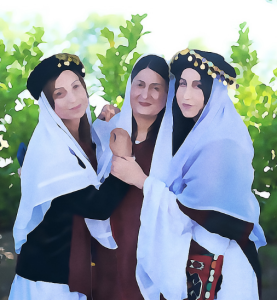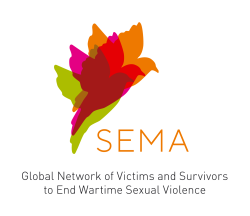This article was written by Hala Sefil, a Yazidi survivor and SEMA member from Iraq. The original text in Arabic can be found below.
On August 3, 2014, ISIS fighters, or the so-called Islamic State, attacked the Shingal area (Sinjar), located in the west of Nineveh Governorate in northern Iraq, 80 km away from the city of Mosul. The organization forced 130,000 Yazidis to flee to the areas of the Kurdistan Region, and with nowhere else to seek refuge, tens of thousands of them were forced to seek refuge in the Sinjar Mountains for fear of ISIS under dire conditions. At least 1,700 people died due to a lack of water, food and medical equipment. ISIS killed thousands of men, children and the elderly as they invaded the judiciary, and they tortured nearly 4,200 girls and women, who were enslaved and sold in slave markets. The organization committed violations against the Yazidi community on a large scale, including forced conversion to Islam, separation of families, the enslavement of women and surviving children who were considered “spoils of war”, and the recruitment of young children who were forced to fight in their ranks.
The Islamic State of Iraq and the Levant (ISIL) captured the Yazidis who were fleeing toward the Sinjar Mountain in the village of Qani on August 3, 2014. They separated the women and children from the men and took the men to a valley near the village where they were brutally executed and dumped in four mass graves and two killing sites. About 400 people were killed or kidnapped in the village of Qani.
On Tuesday, June 28 this year, a ceremony was held to open five mass graves containing the remains of the people of Sinjar and the village of Qani, east of the Sinjar district. Those remains will be transferred to Baghdad for identification and then returned to their families in Sinjar for a burial ceremony.
Hala Sefil, a Yazidi survivor and human rights activist, commented, “After a lot of advocacy that lasted for many years, five mass graves were exhumed in Qani village, out of 80 mass graves in Sinjar district. Excavations were carried out in the presence of the victims’ families and a large number of members of the Yazidi community, but unfortunately, in the absence of government representatives, that was one of the most difficult days in my life because those cemeteries contained the remains of my family, including my brother and my father. There should be a special cemetery for these remains and for the victims of the genocide. About 106 people were martyred in the village of Qani by the terrorist organization ISIS. The opening of these mass graves shows the world the extent of the genocide that the Yazidi community has been exposed to. Unfortunately, and although there are hundreds of mass graves in Iraq, there is only one team working on excavating and opening mass graves. That’s why the team works very slowly and cannot continue without adequate support. It is worth mentioning that this team is working to open mass graves in the village of Qani with the support of humanitarian organizations, not from the Iraqi government.”

في 3 من آب 2014، هاجم مقاتلو “داعش” او مايسمى بالدولة الإسلامية منطقة شنكال (سنجار) الواقعة غرب محافظة نينوى شمال العراق وتبعد عن مدينة الموصل 80 كم. أجبر التنظيم 130,000 من الإيزيديين على الفرار صوب مناطق أقليم كردستان ومع عدم وجود مكان آخر يلوذون به، أُجبر عشرات الآلاف منهم على اللجوء إلى جبال سنجار خوفاً من داعش في ظل ظروف بالغة السوء. ومات ما لا يقل عن 1,700 شخص بسبب نقص المياه والطعام والمعدات الطبية. قتل داعش الآلاف من الرجال والاطفال وكبار السن أثناء اجتياحهم القضاء وقاموا بسي ما يقارب 4200 فتاة وامرأة وتم استعبادهن وبيعهن في أسواق النخاسة. أرتكب التنظيم انتهاكات بحق المجتمع الايزيدي على نطاق واسع، منها إرغام على التحوّل إلى الإسلام، وفصل للعائلات واسترقاق للنساء والأطفال الناجين الذين تم اعتباراهم “غنائم حرب”وتجنيد الاطفال الصغار و إجبارهم على القتال في صفوفهم.
أسر تنظيم الدولة الإسلامية في العراق والشام الأيزيديين الذين كانوا يفرون باتجاه جبل سنجار في قرية قني وضواحيها في الثالث من أب 2014. قاموا بفصل النساء والأطفال عن الرجال ونقلوا الرجال إلى واد بالقرب من القرية حيث تم إعدامهم بوحشية وإلقائهم في اربع مقابر جماعية وموقعين للقتل. قُتل أو خُطف حوالي 400 شخص في قرية قني.
اجريت يوم الثلاثاء المصادف 28 من يونيو هذا العام مراسم فتح خمس مقابر جماعية تضم رفات أهالي سنجار وقرية قني شرق قضاء سنجار.استشهد العديد من اهالي قرية قني على يد تنظيم داعش قبل ثمانية اعوام في 3 اب 2014 واليوم تم استخراج رفات ل 100 شهيداً من الرجال والنساء الأيزيديين من خمس مقابر جماعية .وسيتم نقل تلك الرفات الى بغداد بهدف تحديد هوياتهم وبعد ذلك اعادتها الى ذويها في سنجار من اجل مراسيم الدفن الكريمة.
علقت حلا سفيل أحدى الناجيات الإيزيديات والناشطة في مجال حقوق الانسان قائلة، “بعد الكثير من المناصرة التي دامت لسنوات كثيرة، تم فتح خمس مقابر جماعية في قرية قني، من أصل 80 مقبرة جماعية في قضاء سنجار. أجريت مراسيم التنقيب بحضور ذوي الضحايا وعدد كبير من أبناء المجتمع الإيزيدي ولكن بغياب ممثلي الحكومة مع الأسف، كان ذلك من أصعب الأيام في حياتي لأن تلك المقابر كانت تضم رفات عائلتي منها أخي وأبي. نرى أننا نحقق نجاحاً مهماً في مناصرتنا بعد فتح هذه المقابر وسنستمر لحين فتح المقابر الاخرى في المنطقة وأجراء مراسيم الدفن الكريمة لهذه الرفات وتخصيص مقبرة خاصة لضحايا الإبادة. أستشهد ما يقارب 106 شخصاً في قرية قني على يد تنظيم داعش الإرهابي. فتح هذه المقابر الجماعية يبين للعالم حجم الإبادة التي تعرض له المجتمع الإيزيدي. للأسف هناك فقط فريق واحد يعمل على تنقيب وفتح المقابر الجماعية في العراق على الرغم من هناك المئات من المقابر الجماعية فيه لهذا يعمل الفريق بشكلٍ بطيء جداً ولا يمكنه الاستمرار دون وجود دعم مناسب. ومن الجدير بالذكر ان هذا الفريق يعمل على فتح المقابر الجماعية في قرية قني بدعم من المنظمات الإنسانية وليس من الحكومة العراقية.”

